Ford F-150 2005 User Manual
|
Table of Contents |
|
|
Introduction |
4 |
|
|
|
|
Instrument Cluster |
10 |
|
|
Warning and control lights |
10 |
Gauges |
15 |
|
|
Entertainment Systems |
18 |
|
|
AM/FM stereo |
18 |
AM/FM stereo with CD |
20 |
AM/FM stereo cassette with CD |
23 |
AM/FM stereo with in-dash six CD |
26 |
|
|
Climate Controls |
32 |
|
|
Heater only |
32 |
Manual heating and air conditioning |
33 |
Automatic temperature control |
36 |
Rear window defroster |
41 |
|
|
Lights |
42 |
|
|
Headlamps |
42 |
Turn signal control |
45 |
Bulb replacement |
47 |
|
|
Driver Controls |
53 |
|
|
Windshield wiper/washer control |
53 |
Steering wheel adjustment |
54 |
Power windows |
59 |
Mirrors |
61 |
Speed control |
64 |
Message center |
72 |
Tailgate |
82 |
1
2005 F-150 (f12)
Owners Guide (post-2002-fmt)
USA (fus)

Table of Contents
Locks and Security |
85 |
|
|
Keys |
85 |
Locks |
85 |
Anti-theft system |
96 |
|
|
Seating and Safety Restraints |
100 |
|
|
Seating |
100 |
Safety restraints |
105 |
Airbags |
124 |
Child restraints |
132 |
|
|
Tires, Wheels and Loading |
149 |
|
|
Tire Information |
151 |
Tire Inflation |
154 |
Changing tires |
157 |
Lug Nut Torque |
163 |
Vehicle loading |
172 |
Trailer towing |
179 |
Recreational towing |
187 |
|
|
Driving |
189 |
|
|
Starting |
189 |
Brakes |
194 |
Transmission operation |
198 |
|
|
Roadside Emergencies |
222 |
|
|
Getting roadside assistance |
222 |
Hazard flasher switch |
223 |
Fuel pump shut-off switch |
223 |
Fuses and relays |
224 |
Jump starting |
231 |
Wrecker towing |
236 |
2
2005 F-150 (f12)
Owners Guide (post-2002-fmt)
USA (fus)
|
Table of Contents |
|
|
Customer Assistance |
237 |
|
|
Reporting safety defects (U.S. only) |
245 |
|
|
Cleaning |
246 |
|
|
|
|
Maintenance and Specifications |
254 |
|
|
Engine compartment |
256 |
Engine oil |
259 |
Battery |
263 |
Engine Coolant |
265 |
Fuel information |
271 |
Air filter(s) |
289 |
Part numbers |
291 |
Refill capacities |
292 |
Lubricant specifications |
295 |
|
|
Accessories |
304 |
|
|
|
|
Index |
307 |
|
|
All rights reserved. Reproduction by any means, electronic or mechanical including photocopying, recording or by any information storage and retrieval system or translation in whole or part is not permitted without written authorization from Ford Motor Company. Ford may change the contents without notice and without incurring obligation.
Copyright © 2005 Ford Motor Company
3
2005 F-150 (f12)
Owners Guide (post-2002-fmt)
USA (fus)

Introduction
CALIFORNIA Proposition 65 Warning
WARNING: Engine exhaust, some of its constituents, and certain vehicle components contain or emit chemicals known to the State
of California to cause cancer and birth defects or other reproductive harm. In addition, certain fluids contained in vehicles and certain products of component wear contain or emit chemicals known to the State of California to cause cancer and birth defects or other reproductive harm.
CONGRATULATIONS
Congratulations on acquiring your new Ford. Please take the time to get well acquainted with your vehicle by reading this handbook. The more you know and understand about your vehicle, the greater the safety and pleasure you will derive from driving it.
For more information on Ford Motor Company and its products visit the following website:
•In the United States: www.ford.com
•In Canada: www.ford.ca
•In Australia: www.ford.com.au
•In Mexico: www.ford.com.mx
Additional owner information is given in separate publications.
This Owner’s Guide describes every option and model variant available and therefore some of the items covered may not apply to your particular vehicle. Furthermore, due to printing cycles it may describe options before they are generally available.
Remember to pass on this Owner’s Guide when reselling the vehicle. It is an integral part of the vehicle.
Fuel pump shut-off switch: In the event of an accident the safety switch will automatically cut off the fuel supply to the
engine. The switch can also be activated through sudden vibration (e.g. collision when parking). To reset the switch, refer to the Fuel pump shut-off switch in the Roadside Emergencies chapter.
SAFETY AND ENVIRONMENT PROTECTION
 Warning symbols in this guide
Warning symbols in this guide
How can you reduce the risk of personal injury to yourself or others? In this guide, answers to such questions are contained in comments highlighted by the warning triangle symbol. These comments should be read and observed.
4
2005 F-150 (f12)
Owners Guide (post-2002-fmt)
USA (fus)

Introduction
 Warning symbols on your vehicle
Warning symbols on your vehicle
When you see this symbol, it is imperative that you consult the relevant section of this guide before touching or attempting adjustment of any kind.
Protecting the environment
We must all play our part in protecting the environment. Correct vehicle usage and the authorized disposal of waste, cleaning and lubrication materials are significant
steps towards this aim. Information in this respect is highlighted in this guide with the tree symbol.
BREAKING-IN YOUR VEHICLE
Your vehicle does not need an extensive break-in. Try not to drive continuously at the same speed for the first 1,000 miles (1,600 km) of new vehicle operation. Vary your speed frequently in order to give the moving parts a chance to break in.
Drive your new vehicle at least 500 miles (800 km) before towing a trailer. Additionally, during the first 500 miles (800 km) that you tow a trailer, do not drive over 70 mph (112 km/h) and do not make starts at full throttle.
This style of driving will help the engine and other parts of your vehicle break in at the heavier loads. For more detailed information about towing a trailer, refer to Trailer towing in the Tires, Wheels and Loading chapter.
Do not add friction modifier compounds or special break-in oils during the first few thousand miles (kilometers) of operation, since these additives may prevent piston ring seating. See Engine oil in the Maintenance and Specifications chapter for more information on oil usage.
SPECIAL NOTICES
Emission warranty
The New Vehicle Limited Warranty includes Bumper-to-Bumper Coverage, Safety Restraint Coverage, Corrosion Coverage, and 6.0L Power Stroke Diesel Engine Coverage. In addition, your vehicle is eligible for Emissions Defect and Emissions Performance Warranties. For a detailed description of what is covered and what is not covered, refer to the Warranty Guide that is provided to you along with your Owner’s Guide.
5
2005 F-150 (f12)
Owners Guide (post-2002-fmt)
USA (fus)

Introduction
Service Data Recording
Service data recorders in your vehicle are capable of collecting and storing diagnostic information about your vehicle. This potentially includes information about the performance or status of various systems and modules in the vehicle, such as engine, throttle, steering or brake systems. In order to properly diagnose and service your vehicle, Ford Motor Company, Ford of Canada, and service and repair facilities may access vehicle diagnostic information through a direct connection to your vehicle when diagnosing or servicing your vehicle.
Event Data Recording
Other modules in your vehicle — event data recorders — are capable of collecting and storing data during a crash or near crash event. The recorded information may assist in the investigation of such an event. The modules may record information about both the vehicle and the occupants, potentially including information such as:
•how various systems in your vehicle were operating;
•whether or not the driver and passenger seatbelts were buckled;
•how far (if at all) the driver was depressing the accelerator and/or the brake pedal;
•how fast the vehicle was traveling; and
•where the driver was positioning the steering wheel.
To access this information, special equipment must be directly connected to the recording modules. Ford Motor Company and Ford of Canada do not access event data recorder information without obtaining consent, unless pursuant to court order or where required by law enforcement, other government authorities or other third parties acting with lawful authority. Other parties may seek to access the information independently of Ford Motor Company and Ford of Canada.
Special instructions
For your added safety, your vehicle is fitted with sophisticated electronic controls.
Please read the section Supplemental restraint system (SRS)  in the Seating and Safety Restraints chapter. Failure to follow the specific warnings and instructions could result in personal injury.
in the Seating and Safety Restraints chapter. Failure to follow the specific warnings and instructions could result in personal injury.
6
2005 F-150 (f12)
Owners Guide (post-2002-fmt)
USA (fus)

Introduction
Front seat mounted rear-facing child or infant seats should NEVER be placed in front of an active passenger air bag.
Using your vehicle with a snowplow
For more information and guidelines for using your vehicle with a snowplow, refer to the Driving chapter.
F150 SuperCrew Owners: Snowplowing
Your vehicle is not recommended for snowplowing. Ford makes no representation as to the suitability of your vehicle for snowplowing, in particular regarding the potential for exceeding vehicle weight limits, airbag (SRS) deployment sensitivity, vehicle crash integrity, or powertrain durability. The Snowplow Package Option is not available.
Using your vehicle as an ambulance
Do not use this vehicle as an ambulance.
Your vehicle is not equipped with the Ford Ambulance Preparation Package.
Notice to owners of pickup trucks and utility type vehicles
Utility vehicles have a significantly higher rollover rate than other types of vehicles.
Before you drive your vehicle, please read this Owner’s Guide carefully. Your vehicle is not a passenger car. As with other vehicles of this type, failure to operate this vehicle correctly may result in loss of vehicle control, vehicle rollover, personal injury or death.
Be sure to read Driving off road in the Driving chapter.
MIDDLE EAST/NORTH AFRICA VEHICLE SPECIFIC INFORMATION
For your particular global region, your vehicle may be equipped with features and options that are different from the ones that are described in this Owner’s Guide; therefore, a supplement has been supplied that complements this book. By referring to the pages in the provided supplement, you can properly identify those features, recommendations and specifications that are unique to your vehicle. Refer to this
Owner’s Guide for all other required information and warnings.
7
2005 F-150 (f12)
Owners Guide (post-2002-fmt)
USA (fus)
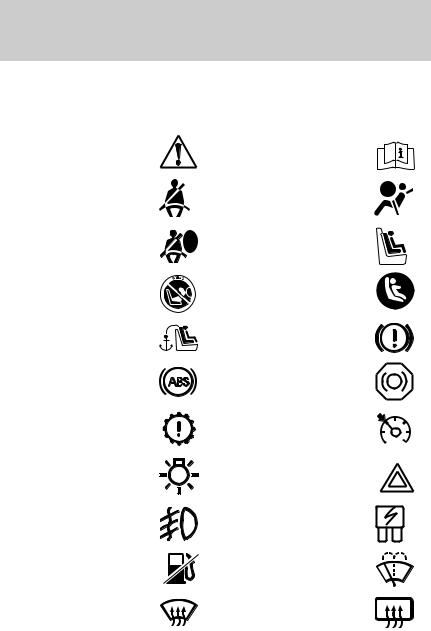
Introduction
These are some of the symbols you may see on your vehicle.
Vehicle Symbol Glossary |
||
Safety Alert |
See Owner’s Guide |
|
Fasten Safety Belt |
Air Bag-Front |
|
Air Bag-Side |
Child Seat |
|
Child Seat Installation |
Child Seat Lower |
|
Warning |
Anchor |
|
Child Seat Tether |
Brake System |
|
Anchor |
||
|
||
Anti-Lock Brake System |
Brake Fluid - |
|
Non-Petroleum Based |
||
|
||
Powertrain Malfunction |
Speed Control |
|
Master Lighting Switch |
Hazard Warning Flasher |
|
Fog Lamps-Front |
Fuse Compartment |
|
Fuel Pump Reset |
Windshield Wash/Wipe |
|
Windshield |
Rear Window |
|
Defrost/Demist |
Defrost/Demist |
|
8 |
|
|
2005 F-150 (f12)
Owners Guide (post-2002-fmt)
USA (fus)
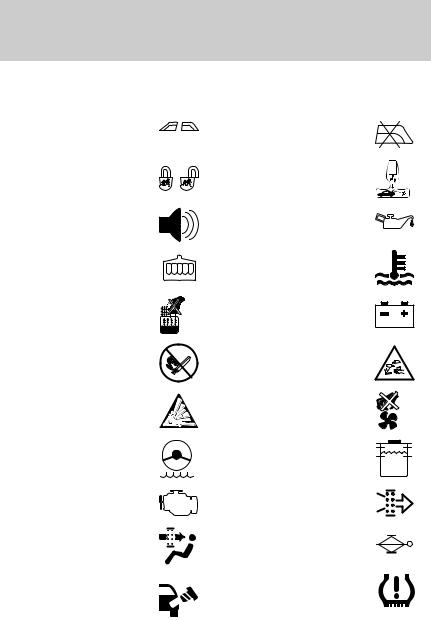
Introduction
Vehicle Symbol Glossary
Power Windows
Power Window Lockout
Front/Rear
Child Safety Door
Interior Luggage
Lock/Unlock
Compartment Release
Symbol
Panic Alarm |
Engine Oil |
Engine Coolant
Engine Coolant
Temperature
Do Not Open When Hot |
Battery |
Avoid Smoking, Flames,
Battery Acid
or Sparks
Explosive Gas |
Fan Warning |
Power Steering Fluid
Maintain Correct Fluid
Level
Emission System |
Engine Air Filter |
|
Passenger Compartment |
Jack |
|
Air Filter |
||
|
Check Fuel Cap
Low Tire Pressure
Warning
MAX
MIN
9
2005 F-150 (f12)
Owners Guide (post-2002-fmt)
USA (fus)
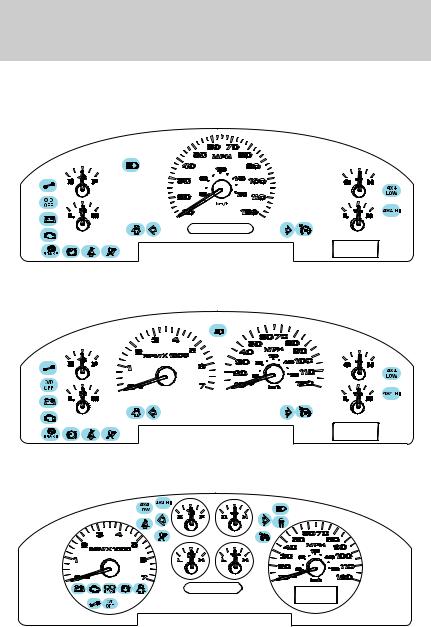
Instrument Cluster
WARNING LIGHTS AND CHIMES
Base instrument cluster
Base with Tachometer instrument cluster
Mid instrument cluster
10
2005 F-150 (f12)
Owners Guide (post-2002-fmt)
USA (fus)
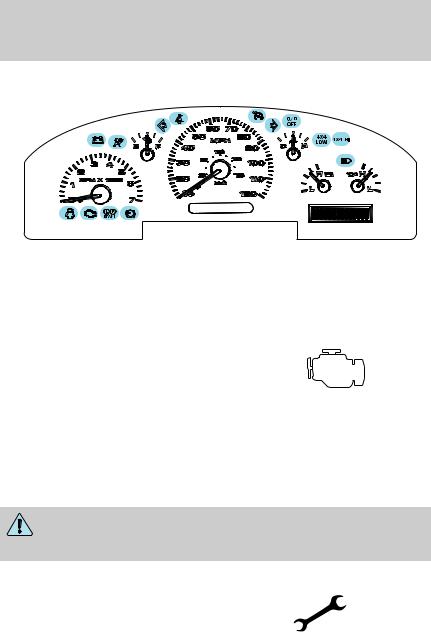
Instrument Cluster
Luxury instrument cluster
Warning lights and gauges can alert you to a vehicle condition that may become serious enough to cause expensive repairs. A warning light may illuminate when a problem exists with one of your vehicle’s functions.
Many lights will illuminate when you start your vehicle to make sure the bulb works. If any light remains on after starting the vehicle, refer to the respective system warning light for additional information.
Service engine soon: The Service engine soon indicator light illuminates when the ignition is first turned to the ON position to check
the bulb. Solid illumination after the engine is started indicates the On Board Diagnostics System (OBD-II) has detected a malfunction. Refer to
On board diagnostics (OBD-II) in the Maintenance and Specifications chapter. If the light is blinking, engine misfire is occurring which could damage your catalytic converter. Drive in a moderate fashion (avoid heavy acceleration and deceleration) and have your vehicle serviced immediately by your authorized dealer.
Under engine misfire conditions, excessive exhaust temperatures could damage the catalytic converter, the fuel system, interior
floor coverings or other vehicle components, possibly causing a fire.
Electronic throttle control (if equipped): Illuminates when the engine has defaulted to a ’limp-home’ operation. Report the
fault to a dealer at the earliest opportunity.
11
2005 F-150 (f12)
Owners Guide (post-2002-fmt)
USA (fus)
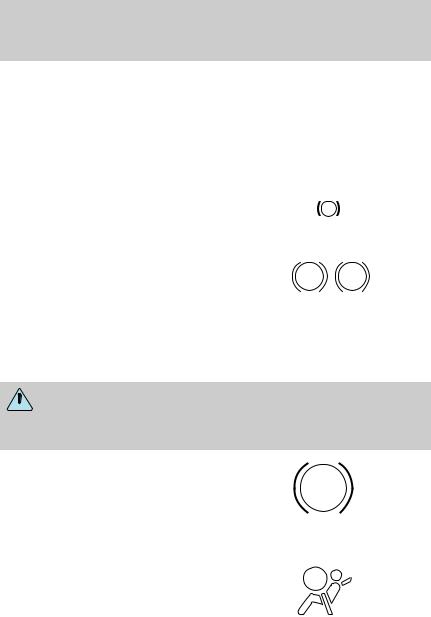
Instrument Cluster
On vehicles equipped with a message center, “ENGINE FAILSAFE MODE” will be displayed, refer to Message Center in the Driver Controls chapter.
Brake system warning light: To confirm the brake system warning light is functional, it will momentarily illuminate when the ignition is turned to the ON position when the engine is not running, or in a position between ON and START, or by applying the parking brake when the ignition is turned to the ON position.
Base with and without |
|
! |
Tachometer instrument cluster |
|
|
|
BRAKE |
|
Mid and Luxury instrument |
! |
P |
cluster |
||
If the brake system warning light |
BRAKE |
|
does not illuminate at this time, |
||
|
seek service immediately from your
authorized dealer. Illumination after releasing the parking brake indicates low brake fluid level and the brake system should be inspected immediately by your authorized dealer.
Driving a vehicle with the brake system warning light on is
 dangerous. A significant decrease in braking performance may occur. It will take you longer to stop the vehicle. Have the vehicle checked by your authorized dealer.
dangerous. A significant decrease in braking performance may occur. It will take you longer to stop the vehicle. Have the vehicle checked by your authorized dealer.
Anti-lock brake system: If the ABS light stays illuminated or continues to flash, a malfunction has been detected, have the system serviced immediately by your
ABS
authorized dealer. Normal braking is still functional unless the brake warning light also is illuminated.
Air bag readiness: If this light fails to illuminate when ignition is turned to ON, continues to flash or remains on, have the system serviced immediately by your authorized
dealer. A chime will also sound when a malfunction in the supplemental restraint system has been detected.
12
2005 F-150 (f12)
Owners Guide (post-2002-fmt)
USA (fus)
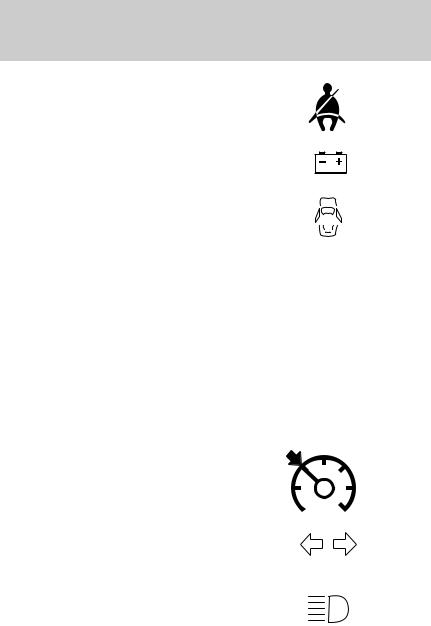
Safety belt: Reminds you to fasten your safety belt. A chime will also sound to remind you to fasten your safety belt.
Charging system: Illuminates when the battery is not charging properly.
Door ajar: Illuminates when the ignition is in the ON position and any door is open.
Overdrive off (if equipped):
Illuminates when the overdrive function of the transmission has been turned off, refer to the
Driving chapter. If the light flashes steadily or does not illuminate, have the transmission serviced soon, or damage may occur.
Four wheel drive low: Illuminates when four-wheel drive low is engaged.
Four wheel drive high: Illuminates when four-wheel drive high is engaged.
Speed control: Illuminates when the speed control is activated. Turns off when the speed control system is deactivated.
4x4 LOW
4x4 HI
Turn signal: Illuminates when the left or right turn signal or the hazard lights are turned on. If the
indicators stay on or flash faster, check for a burned out bulb.
High beams: Illuminates when the high beam headlamps are turned on.
13
2005 F-150 (f12)
Owners Guide (post-2002-fmt)
USA (fus)
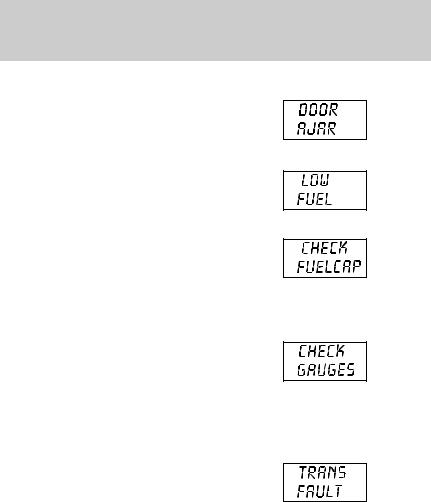
Instrument Cluster
MINI MESSAGE CENTER WARNING DISPLAYS (IF EQUIPPED)
Door ajar: Displays when the ignition is in the ON position and any door is open.
Low fuel: Displays when the fuel level in the fuel tank is at or near empty (refer to Fuel gauge in this chapter).
Check fuel cap: Displays when the fuel cap may not be properly
installed. Continued driving with this display on may cause the
Service engine soon warning light to
come on. Refer to Fuel filler cap in the Maintenance and Specifications chapter.
Check gauge: Displays when any of the following conditions has occurred:
•The engine coolant temperature is high.
•The engine oil pressure is low.
•The fuel gauge is at or near empty.
Trans Fault: Displays when a transmission problem has been detected and shifting may be restricted. If the light remains on, have the system serviced
immediately by your authorized dealer.
Key-in-ignition warning chime: Sounds when the key is left in the ignition in the OFF/LOCK or ACCESSORY position and the driver’s door is opened.
Headlamps on warning chime: Sounds when the headlamps or parking lamps are on, the ignition is off (the key is not in the ignition) and the driver’s door is opened.
14
2005 F-150 (f12)
Owners Guide (post-2002-fmt)
USA (fus)
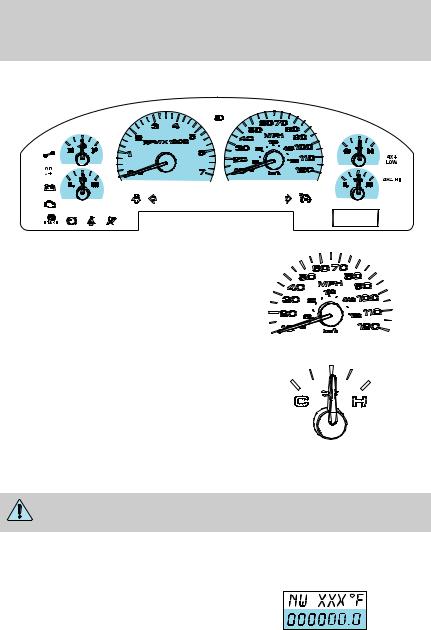
Instrument Cluster
GAUGES
Speedometer: Indicates the current vehicle speed.
Engine coolant temperature gauge: Indicates engine coolant temperature. At normal operating temperature, the needle will be in the normal range (between “H” and “C”). If it enters the red section, the engine is overheating. Stop the
vehicle as soon as safely possible, switch off the engine and let the engine cool.
Never remove the coolant reservoir cap while the engine is running or hot.
Odometer: Registers the total miles (kilometers) of the vehicle.
• With Mini Message Center
15
2005 F-150 (f12)
Owners Guide (post-2002-fmt)
USA (fus)
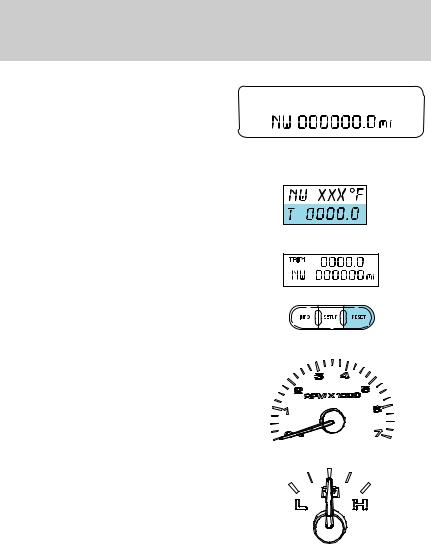
Instrument Cluster
• With Full Message Center
Refer to Message Center in the Drivers Controls chapter on how to switch the display from Metric to English.
Trip odometer: Registers the miles (kilometers) of individual journeys.
• With Mini Message Center
Press and release the button on top of the cluster to toggle between odometer and trip odometer display.
• With Full Message Center
Press and release the message center INFO button until TRIP mode appears in the display. Press the RESET button to reset.
Tachometer (if equipped):
Indicates the engine speed in revolutions per minute. Driving with your tachometer pointer continuously at the top of the scale may damage the engine.
Battery voltage gauge: Indicates the battery voltage when the ignition is in the ON position. If the pointer moves and stays outside the normal operating range, have the vehicle’s electrical system checked by your authorized dealer as soon as possible.
16
2005 F-150 (f12)
Owners Guide (post-2002-fmt)
USA (fus)
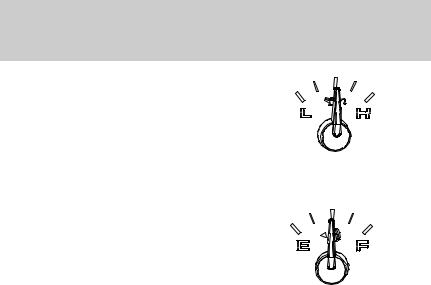
Instrument Cluster
Engine oil pressure gauge:
Indicates engine oil pressure. The needle should stay in the normal operating range (between “L” and “H”). If the needle falls below the normal range, stop the vehicle, turn off the engine and check the engine
oil level. Add oil if needed. If the oil level is correct, have your vehicle checked at your authorized dealer.
Fuel gauge: Indicates approximately how much fuel is left in the fuel tank (when the ignition is in the ON position). The fuel gauge may vary slightly when the vehicle is in motion or on a grade.
The arrow next to the fuel pump
icon indicates which side of the vehicle the fuel filler door is located.
For more information, refer to Filling the tank in the Maintenance and Specifications chapter.
17
2005 F-150 (f12)
Owners Guide (post-2002-fmt)
USA (fus)
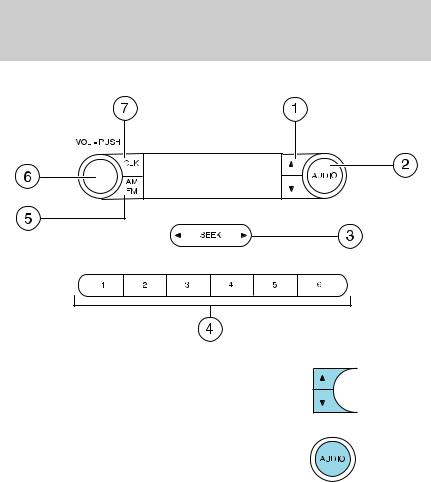
Entertainment Systems
FORD AM/FM STEREO SYSTEM (IF EQUIPPED)
1.  /
/  Tune: Press to manually
Tune: Press to manually
go up or down the radio frequency. Also use in menu mode to select various settings.
2. Audio: Press to access select various settings.
Treble: Press to adjust the treble setting. Use  /
/ /
/ SEEK, SEEK
SEEK, SEEK  .
.
Bass: Press to adjust the bass setting. Use  /
/ /
/ SEEK, SEEK
SEEK, SEEK  .
.
Balance: Press to adjust the audio between the left and right speakers. Use  /
/ /
/ SEEK, SEEK
SEEK, SEEK  .
.
Fade: Press to adjust the audio between the front and rear speakers. Use  /
/ /
/ SEEK, SEEK
SEEK, SEEK  .
.
18
2005 F-150 (f12)
Owners Guide (post-2002-fmt)
USA (fus)
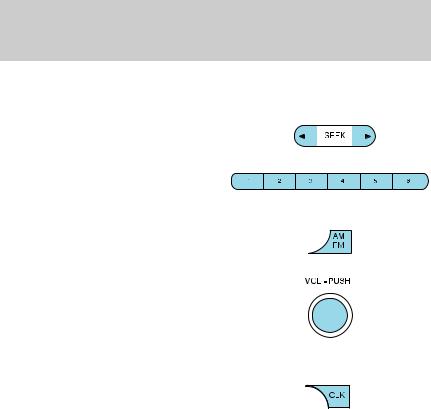
Entertainment Systems
Setting the clock: Press until HR or Mn is displayed. Press  /
/ /
/ SEEK
SEEK  to adjust the hours/minutes.
to adjust the hours/minutes.
3. Seek: Press to access the next/previous strong station.
4. Memory presets: To set a station: Select frequency band AM/FM; tune to a station, press and
hold a preset button until sound returns.
5. AM/FM: Press to select AM/FM frequency band.
6. ON/OFF/Volume: Press to turn ON/OFF. Turn to increase/decrease
volume.
If the volume is set above a certain level and the ignition is turned off, the volume will come back on at a
“nominal” listening level when the ignition switch is turned back on.
7. CLK (Clock): Press CLK to toggle between displaying the radio frequency and the clock setting.
19
2005 F-150 (f12)
Owners Guide (post-2002-fmt)
USA (fus)

Entertainment Systems
FORD SINGLE CD SOUND SYSTEM (IF EQUIPPED)
1.  /
/  Tune: Press to manually
Tune: Press to manually
go up or down the radio frequency. Also use in menu mode to select various settings.
2. Phone/mute: Press to mute the playing media. Press again to return to the playing media.
3. Menu: Press to toggle through the following modes:
Treble: Press to adjust the treble setting. Use  /
/ /
/ SEEK, SEEK
SEEK, SEEK  .
.
Bass: Press to adjust the bass setting. Use  /
/ /
/ SEEK, SEEK
SEEK, SEEK  .
.
Balance: Press to adjust the audio between the left and right speakers. Use  /
/ /
/ SEEK, SEEK
SEEK, SEEK  .
.
20
2005 F-150 (f12)
Owners Guide (post-2002-fmt)
USA (fus)

Entertainment Systems
Fade: Press to adjust the audio between the front and rear speakers. Use  /
/ /
/ SEEK, SEEK
SEEK, SEEK  .
.
Speed sensitive volume: Radio volume automatically changes slightly with vehicle speed to compensate for road and wind noise.
Use  /
/ /
/ SEEK, SEEK
SEEK, SEEK  to adjust.
to adjust.
Autoset: Allows you to set the strongest local radio stations without losing your original manually set preset stations for AM/FM1/FM2 .
Use  /
/ /
/ SEEK, SEEK
SEEK, SEEK  to turn on/off.
to turn on/off.
When the six strongest stations are filled, the station stored in preset 1 will begin playing. If there are less than six strong stations, the system will store the last one in the remaining presets.
Setting the clock: Press until SELECT HOUR or SELECT MINS is displayed. Use  /
/ /
/ SEEK, SEEK
SEEK, SEEK  to adjust the hours/minutes.
to adjust the hours/minutes.
4.Aux: Press to toggle between FES/DVD and AUX modes. If no auxiliary sources are available, NO AUX AUDIO will be displayed.
5.Seek: Press to access the next strong station or track.
6. Text: This control currently not supported.
7. Shuffle: Press to play tracks in random order on the selected CD.
8. Comp (Compression): In CD mode, brings soft and loud CD passages together for a more consistent listening level.
9. Repeat: Press to repeat the current CD track.
21
2005 F-150 (f12)
Owners Guide (post-2002-fmt)
USA (fus)
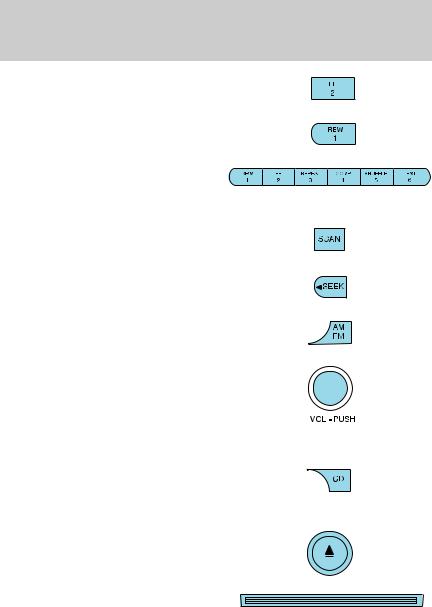
Entertainment Systems
10. Fast forward: Press to manually advance in a CD track.
11. Rewind: Press to manually reverse in a CD track.
12. Memory presets: To set a station: Select frequency band AM/FM; tune to a station, press and
hold a preset button until sound returns.
13.Scan: Press for a brief sampling of radio stations or CD tracks. Press again to stop.
14.Seek: Press to access the next strong station or track.
15. AM/FM: Press to select AM/FM frequency band.
16.ON/OFF/Volume: Press to turn ON/OFF. Turn to increase/decrease volume.
If the volume is set above a certain level and the ignition is turned off, the volume will come back on at a
“nominal” listening level when the ignition switch is turned back on.
17.CD: Press to enter CD mode. If
a CD is already loaded into the system, CD play will begin where it ended last.
18. CD eject: Press to eject a CD.
19. CD slot: Insert a CD label side up.
22
2005 F-150 (f12)
Owners Guide (post-2002-fmt)
USA (fus)
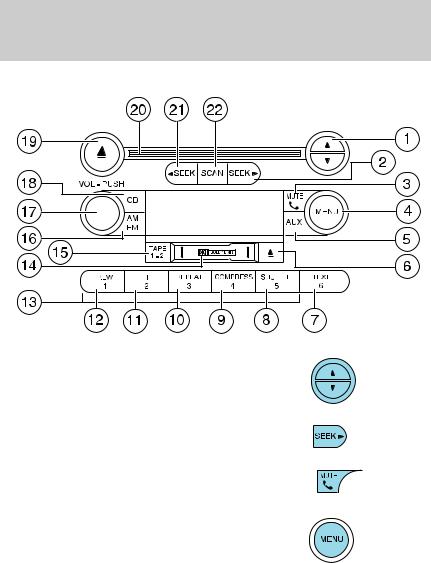
Entertainment Systems
FORD DUAL MEDIA SOUND SYSTEM (IF EQUIPPED)
1.  /
/  Tune: Press to manually
Tune: Press to manually
go up or down the radio frequency. Also use in menu mode to select various settings.
2. Seek: Press to access the next strong station or track.
3. Phone/mute: Press to mute the playing media. Press again to return to the playing media.
4. Menu: Press to toggle through the following modes:
Treble: Press to adjust the treble setting. Use  /
/ /
/ SEEK, SEEK
SEEK, SEEK  .
.
Bass: Press to adjust the bass setting. Use  /
/ /
/ SEEK, SEEK
SEEK, SEEK  .
.
23
2005 F-150 (f12)
Owners Guide (post-2002-fmt)
USA (fus)

Entertainment Systems
Balance: Press to adjust the audio between the left and right speakers. Use  /
/ /
/ SEEK, SEEK
SEEK, SEEK  .
.
Fade: Press to adjust the audio between the front and rear speakers. Use  /
/ /
/ SEEK, SEEK
SEEK, SEEK  .
.
Speed sensitive volume: Radio volume automatically changes slightly with vehicle speed to compensate for road and wind noise.
Use  /
/ /
/ SEEK, SEEK
SEEK, SEEK  to adjust.
to adjust.
Autoset: Allows you to set the strongest local radio stations without losing your original manually set preset stations for AM/FM1/FM2 .
Use  /
/ /
/ SEEK, SEEK
SEEK, SEEK  to turn on/off.
to turn on/off.
When the six strongest stations are filled, the station stored in preset 1 will begin playing. If there are less than six strong stations, the system will store the last one in the remaining presets.
Setting the clock: Press until SELECT HOUR or SELECT MINS is displayed. Use  /
/ /
/ SEEK, SEEK
SEEK, SEEK  to adjust the hours/minutes.
to adjust the hours/minutes.
5. Aux: Press to toggle between FES/DVD and AUX modes. If no auxiliary sources are available, NO AUX AUDIO will be displayed.
6. Tape eject: Press to eject a tape.
7. Text: This control currently not supported.
8. Shuffle: Press to play CD tracks in random order on the selected CD.
9. Compress (Compression): In CD mode, brings soft and loud CD passages together for a more consistent listening level.
24
2005 F-150 (f12)
Owners Guide (post-2002-fmt)
USA (fus)
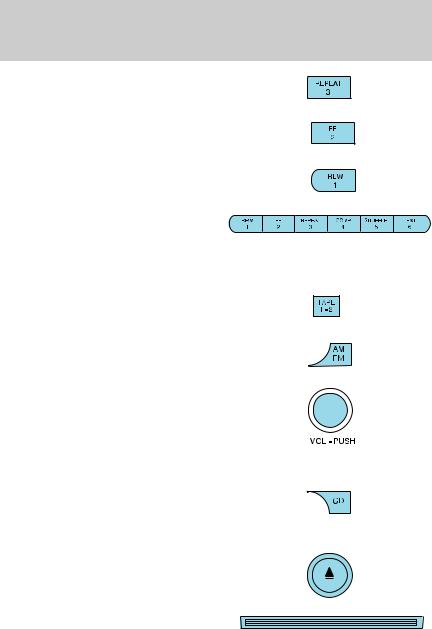
Entertainment Systems
10. Repeat: Press to repeat the current CD track.
11. Fast forward: Press to manually advance in a tape or CD track.
12. Rewind: Press to manually reverse in a tape or CD track.
13. Memory presets: To set a station: Select frequency band AM/FM; tune to a station, press and
hold a preset button until sound returns.
14. Cassette door: Insert a tape, facing to the right.
15. Tape direction: Press to change which side of the tape is playing.
16. AM/FM: Press to select AM/FM frequency band.
17.ON/OFF/Volume: Press to turn ON/OFF. Turn to increase/decrease volume.
If the volume is set above a certain level and the ignition is turned off, the volume will come back on at a
“nominal” listening level when the ignition switch is turned back on.
18.CD: Press to enter CD mode. If
a CD is already loaded into the system, CD play will begin where it ended last.
19. CD eject: Press to eject a CD.
20. CD slot: Insert a CD label side up.
25
2005 F-150 (f12)
Owners Guide (post-2002-fmt)
USA (fus)
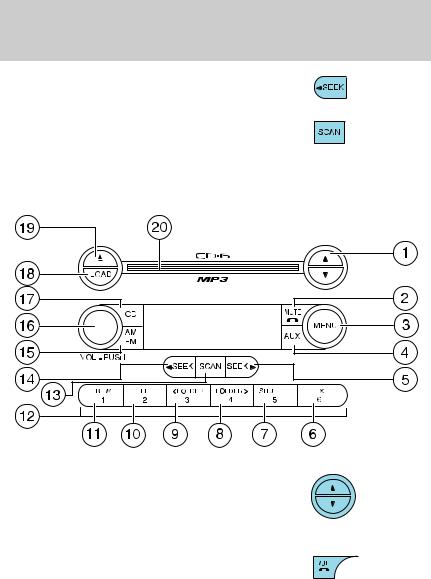
Entertainment Systems
21.Seek: Press to access the previous strong station or track.
22.Scan: Press for a brief sampling of radio stations or CD tracks. Press again to stop.
PREMIUM/AUDIOPHILE IN-DASH SIX CD/MP3 SOUND SYSTEM (IF EQUIPPED)
1.  /
/  Tune/Disc selector:
Tune/Disc selector:
Press to manually go up or down the radio frequency or to select a desired disc. Also use in menu mode to select various settings.
2. Phone/mute: Press to mute the playing media. Press again to return to the playing media.
26
2005 F-150 (f12)
Owners Guide (post-2002-fmt)
USA (fus)

Entertainment Systems
3. Menu: Press to toggle through the following modes:
Autoset: Allows you to set the strongest local radio stations without losing your original manually set preset stations for AM/FM1/FM2 .
Use  /
/ /
/ , SEEK
, SEEK  to turn on/off.
to turn on/off.
When the six strongest stations are filled, the station stored in preset 1 will begin playing. If there are less than six strong stations, the system will store the last one in the remaining presets.
Bass: Press MENU repeatedly to access. Press  /
/ /
/ SEEK
SEEK  to adjust the bass levels.
to adjust the bass levels.
Treble: Press MENU repeatedly to access. Press  /
/ /
/ SEEK
SEEK  to adjust the treble levels.
to adjust the treble levels.
Balance: Press MENU repeatedly to access. Press  /
/ /
/ , SEEK
, SEEK  to adjust the audio between the left and right speakers.
to adjust the audio between the left and right speakers.
Fade: Press MENU repeatedly to access. Press  /
/ /
/ , SEEK
, SEEK  to adjust the audio between the front and rear speakers.
to adjust the audio between the front and rear speakers.
Occupancy mode: (Available on Audiophile radios only): Press MENU repeatedly to access. Press  /
/ /
/ SEEK
SEEK  to optimize sound for ALL SEATS, DRIVERS SEAT or REAR SEATS.
to optimize sound for ALL SEATS, DRIVERS SEAT or REAR SEATS.
Speed sensitive volume: Radio volume automatically changes slightly with vehicle speed to compensate for road and wind noise.
Use  /
/ /
/ SEEK
SEEK  to adjust. Recommended level is 1–3. Level 0 turns the feature off and level 7 is the maximum setting.
to adjust. Recommended level is 1–3. Level 0 turns the feature off and level 7 is the maximum setting.
Setting the clock: Press until SELECT HOUR or SELECT MINS is displayed. Press  /
/ /
/ SEEK
SEEK  to adjust the hours/minutes.
to adjust the hours/minutes.
Track/Folder Mode: Available only on MP3 discs in CD mode. In Track Mode, pressing  SEEK
SEEK  will scroll through all tracks on the disc. In Folder mode, pressing
will scroll through all tracks on the disc. In Folder mode, pressing  SEEK
SEEK  will scroll only through tracks within the selected folder.
will scroll only through tracks within the selected folder.
27
2005 F-150 (f12)
Owners Guide (post-2002-fmt)
USA (fus)
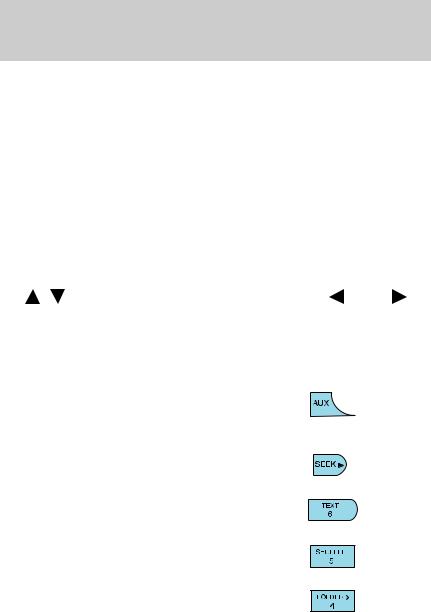
Entertainment Systems
Compression: Available only in CD mode, compression brings soft and loud CD passages together for a more consistent listening level.
Repeat: Available only in CD mode. Press to repeat the current CD track.
RDS (Available on Audiophile radios only): RDS is available in FM mode, and allows you to search RDS-equipped stations for a certain category of music format: Classic, Country, Info, Jazz/RB, Religious, Rock, Soft, Top 40. RDS must be activated to access Find and Show functions.
To activate, press and hold MENU until RDS (ON/OFF) appears in the display. Use  /
/ .
. SEEK
SEEK  to toggle RDS ON/OFF. Then press
to toggle RDS ON/OFF. Then press
MENU repeatedly to scroll through Find, Show and RDS. When RDS is Off, you will not be able to access Find and Show functions.
Find: RDS must be activated to access the Find function. Find allows you to search RDS-equipped stations for the desired music category.
Use |
/ |
to find the desired program type, then use |
SEEK |
or |
SCAN to begin the search.
Show: RDS must be activated to access the Show function. Show allows you to display the name of the radio station or program type.
Use  /
/ /
/ SEEK
SEEK  to show type, name or none.
to show type, name or none.
4.Aux: Press to toggle between FES/DVD and AUX modes. If no auxiliary sources are available, NO AUX AUDIO will be displayed.
5.Seek: Press to access the next strong station or track.
6. Text: In CD mode, this feature reads and displays track song title, artist name and album title.
7. Shuffle: Press to play the tracks in random order.
8. FOLDER: Press to access next folder on MP3 discs, if folders are available.
28
2005 F-150 (f12)
Owners Guide (post-2002-fmt)
USA (fus)
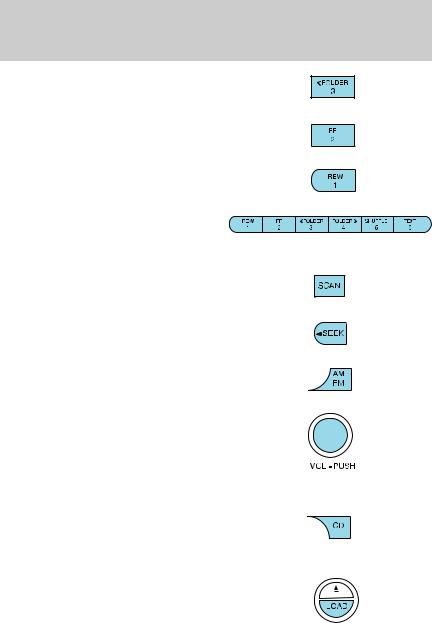
Entertainment Systems
9. FOLDER: press to access the previous folder on MP3 discs, if folders are available.
10. Fast forward: Press to manually advance in a CD track.
11. Rewind: Press to manually reverse in a CD track.
12. Memory presets: To set a station: Select frequency band AM/FM; tune to a station, press and
hold a preset button until sound returns.
13.Scan: Press for a brief sampling of radio stations or CD tracks. Press again to stop.
14.Seek: Press to access the previous strong station or track.
15. AM/FM: Press to select AM/FM frequency band.
16.ON/OFF/Volume: Press to turn ON/OFF. Turn to increase/decrease volume.
If the volume is set above a certain level and the ignition is turned off, the volume will come back on at a
“nominal” listening level when the ignition switch is turned back on.
17.CD: Press to enter CD mode. If
a CD is already loaded into the system, CD play will begin where it ended last.
18. LOAD: Press to load a CD. Press LOAD and a memory preset to load to a specific slot. Press and hold to autoload up to six CDs.
29
2005 F-150 (f12)
Owners Guide (post-2002-fmt)
USA (fus)

Entertainment Systems
19. CD eject: Press to eject a CD. Press and hold to auto eject all CDs present in the system. If there is no
CD present, the display will read NO CD.
20. CD slot: Insert a CD label side up.
FAMILY ENTERTAINMENT SYSTEM (IF EQUIPPED)
Your vehicle may be equipped with a Family Entertainment System (FES). Refer to the DVD Supplement Guide for further information on your system.
RADIO FREQUENCIES
AM and FM frequencies are established by the Federal Communications Commission (FCC) and the Canadian Radio and Telecommunications Commission (CRTC). Those frequencies are:
AM - 530, 540–1700, 1710 kHz
FM87.7, 87.9–107.7, 107.9 MHz
RADIO RECEPTION FACTORS
There are three factors that can affect radio reception:
•Distance/strength: The further you travel from an FM station, the weaker the signal and the weaker the reception.
•Terrain: Hills, mountains, tall buildings, power lines, electric fences, traffic lights and thunderstorms can interfere with your reception.
•Station overload: When you pass a broadcast tower, a stronger signal may overtake a weaker one and play while the weak station frequency is displayed.
CASSETTE/PLAYER CARE
Do:
•Use only cassettes that are 90 minutes long or less.
•Tighten very loose tapes by inserting a finger or pencil into the hole and turning the hub.
•Remove loose labels before inserting tapes.
•Allow tapes which have been subjected to extreme heat, humidity or cold to reach a moderate temperature before playing.
30
2005 F-150 (f12)
Owners Guide (post-2002-fmt)
USA (fus)
